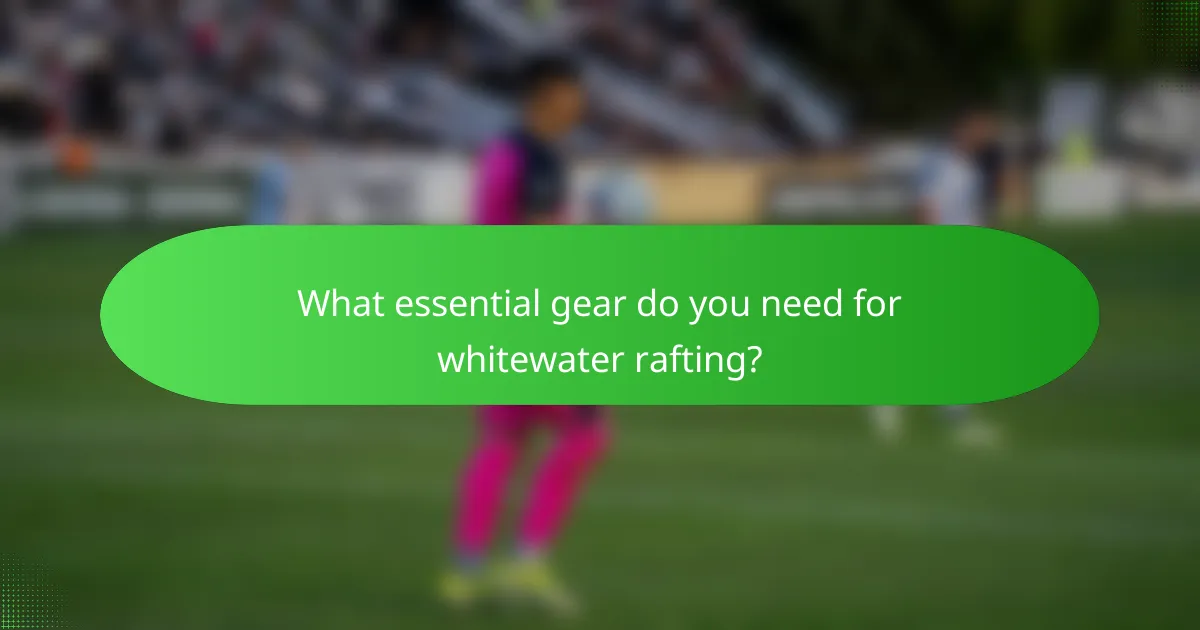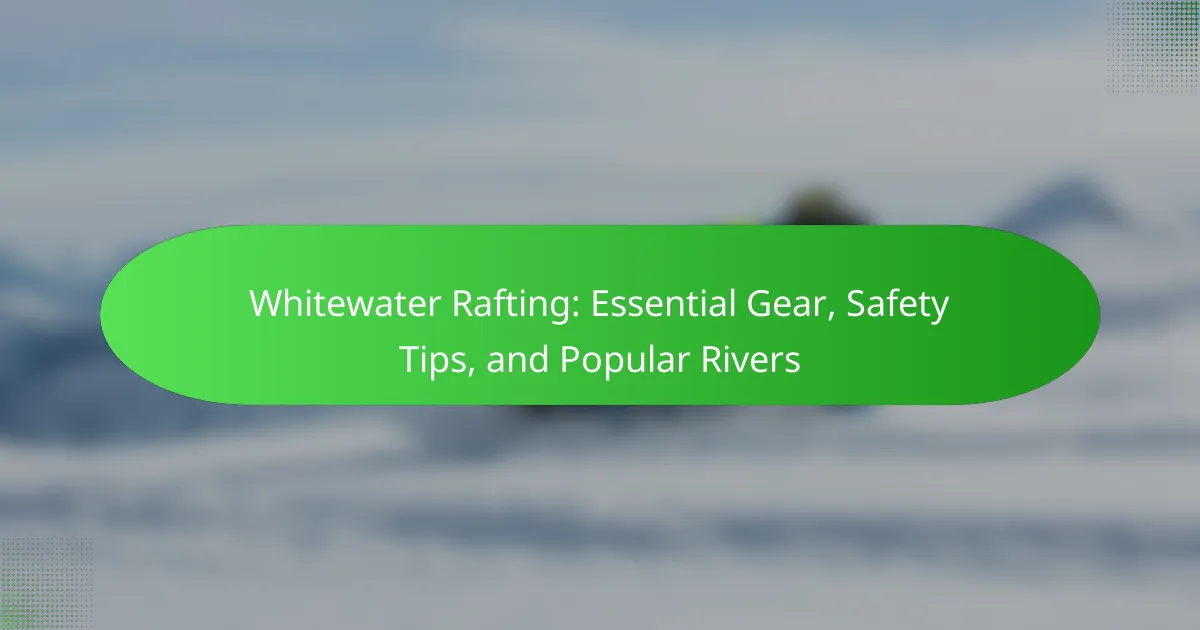Whitewater rafting offers thrilling adventures, but safety and preparation are crucial for an enjoyable experience. Essential gear includes a personal flotation device, helmet, and paddle. Safety tips emphasize communication and awareness of river conditions. Popular rivers like the Colorado and Salmon provide unique challenges and stunning scenery for all skill levels.

What essential gear do you need for whitewater rafting?
For whitewater rafting, essential gear includes a personal flotation device, helmet, paddle, and appropriate clothing. Each item enhances safety and comfort during the adventure.
1. Personal Flotation Device (PFD) – Ensures buoyancy and safety in water.
2. Helmet – Protects against head injuries from rocks and debris.
3. Paddle – Enables control and maneuverability of the raft.
4. Wetsuit or Dry Suit – Provides thermal protection in cold water.
5. Footwear – Offers grip and protection on slippery surfaces.
6. Safety Whistle – Alerts others in case of emergencies.
Why is a personal flotation device crucial for safety?
A personal flotation device is crucial for safety because it provides buoyancy and helps prevent drowning in water. This gear is essential during whitewater rafting, where unpredictable currents and obstacles increase risks. Wearing a properly fitted personal flotation device can significantly enhance survival chances. Studies show that 80% of drowning victims were not wearing life jackets, highlighting their importance in water sports.
How do paddles and oars vary in design and function?
Paddles and oars differ in design and function primarily through their structure and use in watercraft. Paddles are typically shorter, used in a kneeling position, and rely on the user’s strength to propel the craft. Oars are longer, used with oarlocks, and leverage the boat’s weight for propulsion. Paddles offer maneuverability, while oars provide stability and power.
Which protective clothing enhances comfort and safety?
Protective clothing that enhances comfort and safety in whitewater rafting includes high-quality wetsuits, drysuits, and personal flotation devices (PFDs). Wetsuits provide thermal insulation, while drysuits offer complete waterproof protection. PFDs ensure buoyancy and safety during rafting activities. Selecting gear with breathable materials enhances comfort during extended use.
What are the benefits of using a dry bag for gear storage?
Using a dry bag for gear storage offers significant benefits for whitewater rafting. These bags provide waterproof protection, keeping gear dry in wet conditions. They are durable, resisting punctures and abrasions, which is essential in rugged environments. Additionally, dry bags are lightweight and easily compressible, allowing for efficient packing and transport. Their versatility enables use for various activities beyond rafting, enhancing overall utility.
How do helmets differ in protection levels for rafting?
Helmets for rafting differ in protection levels based on design, materials, and certification standards. Higher protection levels typically feature reinforced shells and impact-absorbing liners.
| Helmet Type | Design Features | Material | Protection Level |
|———————|——————————-|——————-|——————|
| Standard Rafting | Basic coverage | Polycarbonate | Moderate |
| Full-Face | Extended coverage | ABS plastic | High |
| Whitewater Specific | Enhanced impact resistance | Kevlar composite | Very High |
| Multi-Sport | Versatile use | Lightweight foam | Variable |
Choosing the right helmet enhances safety during rafting, especially in challenging conditions.

What safety tips should you follow while whitewater rafting?
To ensure safety while whitewater rafting, follow these essential tips. Always wear a properly fitted life jacket and helmet. Understand the river’s classification and choose appropriate sections based on your skill level. Communicate clearly with your group and establish hand signals for emergencies. Stay aware of your surroundings and avoid distractions. Secure all gear to prevent loss during rapids. Finally, never raft alone; always go with experienced guides or friends.
How can you assess river conditions before embarking?
To assess river conditions before embarking on whitewater rafting, check water levels, flow rates, and weather forecasts. Use local resources, such as river gauge websites, to obtain real-time data. Evaluate the river’s difficulty rating and consult with experienced rafters or guides for insights. Always prioritize safety by understanding the unique attributes of the river, including potential hazards and seasonal changes.
What communication signals are essential among rafting teams?
Effective communication signals among rafting teams include hand signals, verbal commands, and whistle alerts. These signals ensure safety and coordination during navigation.
Hand signals are crucial for conveying messages without shouting over water noise. Common signals include raising a paddle for “stop” and a fist for “go.” Verbal commands, such as “forward” or “back,” help synchronize paddling efforts. Whistle alerts serve as a quick way to gain attention in emergencies.
Establishing these communication methods before hitting the water enhances team performance and safety, making them essential attributes for successful whitewater rafting experiences.
Why is it important to understand swift water rescue techniques?
Understanding swift water rescue techniques is crucial for ensuring safety during whitewater rafting. These techniques help prevent accidents and save lives in dangerous conditions. Knowledge of swift water rescue allows rafters to respond effectively to emergencies, minimizing risks associated with swift currents and obstacles. Additionally, mastering these skills enhances overall rafting confidence and promotes responsible outdoor practices.
What role does a guide play in ensuring safety on the river?
A guide plays a crucial role in ensuring safety on the river by providing expert knowledge and oversight. They assess river conditions, identify hazards, and instruct participants on safety protocols. Guides also manage equipment and navigate challenging sections, minimizing risks. Their experience is vital for making quick decisions during emergencies, ensuring a safe and enjoyable experience for all.

Which rivers are popular for whitewater rafting adventures?
The most popular rivers for whitewater rafting adventures include the Colorado River, the Salmon River, the Gauley River, the Rogue River, and the Arkansas River. Each offers unique rapids and stunning scenery. The Colorado River features intense rapids through the Grand Canyon, while the Salmon River is known for its pristine wilderness. The Gauley River offers thrilling Class V rapids, making it a favourite among experienced rafters. The Rogue River provides a mix of fun and scenery, and the Arkansas River is ideal for beginners with its accessible rapids.
What makes the Colorado River a top choice for rafters?
The Colorado River is a top choice for rafters due to its diverse rapids, stunning scenery, and accessibility. The river offers a range of difficulty levels, making it suitable for both beginners and experienced rafters. Its iconic landscapes, including the Grand Canyon, enhance the overall experience. Additionally, the river’s flow is consistent, providing reliable conditions for rafting. The combination of thrilling challenges and breathtaking views makes the Colorado River a premier destination for whitewater enthusiasts.
How does the Gauley River attract enthusiasts every fall?
The Gauley River attracts enthusiasts every fall due to its thrilling whitewater conditions and vibrant autumn scenery. The annual Gauley River Festival further enhances its appeal, offering a celebration of rafting culture. With Class V rapids, the river provides an adrenaline-pumping experience for experienced rafters. Additionally, the stunning fall foliage creates a picturesque backdrop, making it a popular destination for both adventure seekers and nature lovers alike.
What unique features does the Salmon River offer for rafters?
The Salmon River offers unique features for rafters, including stunning scenery, diverse rapids, and abundant wildlife. The river’s challenging sections, like the infamous “Chamberlain Rapids,” provide thrilling experiences for experienced rafters. Additionally, the area boasts rich historical significance, with remnants of Native American culture and early settlers. The Salmon River’s remote location ensures minimal crowds, enhancing the adventure.
Which lesser-known rivers provide thrilling rafting experiences?
Some lesser-known rivers that provide thrilling rafting experiences include the Gauley River in West Virginia, the Salmon River in Idaho, the Rogue River in Oregon, the Tully River in Australia, and the Zambezi River in Africa. Each of these rivers offers unique challenges and stunning scenery for adventure seekers. The Gauley River features intense Class V rapids, while the Salmon River is known for its beautiful wilderness. The Rogue River combines thrilling rapids with picturesque landscapes, and the Tully River is famous for its lush rainforest surroundings. The Zambezi River, with its spectacular views of Victoria Falls, provides a rare combination of adventure and natural beauty.

How do regional differences affect whitewater rafting experiences?
Regional differences significantly influence whitewater rafting experiences through variations in river characteristics, local regulations, and environmental conditions. Different regions offer unique water flow rates, rapids difficulty, and scenic views, which shape the overall adventure. For instance, the Colorado River features intense rapids, while the calm waters of the Delaware River attract beginners. Local regulations can also dictate safety measures, required gear, and permitted rafting seasons, impacting the experience. Additionally, climate and geography affect water levels, which can vary drastically between regions, altering the rafting conditions throughout the year.
What are the seasonal variations in river flow across different regions?
Seasonal variations in river flow significantly affect whitewater rafting conditions. In spring, snowmelt increases river flow, creating thrilling rapids. Summer often sees lower flows, making rivers more accessible but less challenging. Fall can bring variable conditions due to rainfall, while winter typically results in minimal flow. Understanding these patterns helps rafters choose the best times for their adventures.
How do local regulations impact rafting activities?
Local regulations significantly impact rafting activities by dictating safety standards, permitted areas, and operational guidelines. These regulations ensure the protection of both participants and natural environments. For example, some regions require specific gear, such as life jackets and helmets, to enhance safety. Additionally, regulations may limit the number of rafters on certain rivers to prevent overcrowding and preserve ecosystems. Compliance with local laws is essential for a safe and enjoyable rafting experience.
What cultural influences shape whitewater rafting communities?
Cultural influences shaping whitewater rafting communities include regional traditions, environmental awareness, and the spirit of adventure. Local customs often dictate preferred rafting styles and techniques, while environmental advocacy promotes river conservation. Additionally, a shared passion for outdoor experiences fosters community connections and safety practices among rafters.

What common mistakes should you avoid when whitewater rafting?
To avoid common mistakes when whitewater rafting, focus on preparation and awareness. Neglecting safety gear, underestimating river conditions, and ignoring weather changes can lead to dangerous situations. Always wear a life jacket, understand your skill level, and communicate effectively with your team. Familiarize yourself with the river’s features and follow guidelines from experienced guides.
How does improper gear selection compromise safety?
Improper gear selection significantly compromises safety in whitewater rafting. Using inadequate or unsuitable equipment increases the risk of accidents and injuries. For instance, a poorly fitting life jacket may not provide adequate buoyancy, while inappropriate paddles can hinder maneuverability. Additionally, using worn-out gear can lead to equipment failure during critical moments. Ensuring the right gear enhances safety and overall rafting experience.
What are the dangers of neglecting weather conditions?
Neglecting weather conditions during whitewater rafting can lead to severe dangers. Inaccurate assessments may result in unexpected hazards such as sudden floods, strong currents, and hypothermia. These conditions can overwhelm even experienced rafters, increasing the risk of accidents and injuries. Staying informed about weather forecasts and river conditions is essential for safety and enjoyment.
Why is it important to follow proper paddling techniques?
Proper paddling techniques are crucial for safety and efficiency in whitewater rafting. They enhance control over the raft, allowing for better navigation through rapids. Effective paddling reduces the risk of capsizing and minimizes fatigue, ensuring a more enjoyable experience. Additionally, mastering techniques can improve teamwork among paddlers, leading to a more coordinated effort in challenging conditions.
How can overestimating skill levels lead to accidents?
Overestimating skill levels in whitewater rafting can lead to serious accidents. This misjudgment often results in inadequate preparation and risky decision-making. Rafting requires specific skills and knowledge about river conditions, which can be underestimated by inexperienced individuals. As a result, they may face dangerous situations beyond their capabilities, increasing the likelihood of capsizing or collisions. Proper training and awareness of one’s limits are essential for safety in this adventurous sport.
What best practices should you adopt for a successful rafting trip?
To ensure a successful rafting trip, prioritize safety, proper gear, and knowledge of the river. Start by wearing a certified life jacket and helmet. Invest in a high-quality raft and paddles designed for whitewater conditions. Familiarize yourself with the river’s classification and potential hazards. Practice essential skills, such as paddling techniques and rescue procedures, with your team before hitting the water. Always check weather conditions and water levels before departure. Lastly, stay hydrated and maintain communication with your group throughout the journey.
